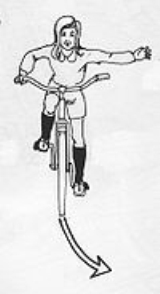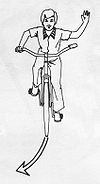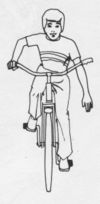
Cycling hand signals
Encyclopedia
Hand signals are given by cyclists and some motorists to indicate their intentions to other traffic
. Under the terms of the Vienna Convention on Traffic
, bicycle
s are considered to be vehicle
s and cyclists are considered to be drivers. The traffic code
s of most countries reflect this.
In some countries (such as in the Czech Republic, Canada, and the USA), hand signals are designated not only for cyclists, but for every vehicle that does not have signal lights or has damaged signal lights. For example, drivers of historical cars and mopeds may be required to make hand signals.
Similar to automobile
signaling, there are three primary signals:
 All Countries : Extend left arm straight out in the direction of the turn, parallel
All Countries : Extend left arm straight out in the direction of the turn, parallel
to the road.
 UK, Germany, Ireland, Italy, Croatia, Russia, Australia, US and Canada (see below) : Extend right arm straight out in the direction of the turn, parallel to the road.
UK, Germany, Ireland, Italy, Croatia, Russia, Australia, US and Canada (see below) : Extend right arm straight out in the direction of the turn, parallel to the road.
US and Canada, (optional) : Extend your left upper-arm out to the left, parallel to the road and angle your forearm vertically upward. This follows automotive practice. The Uniform Vehicle Code
in the US recognizes both this signal and the arm to the right signal for cyclists. State traffic laws generally conform to the Uniform Vehicle Code, but exceptions may exist.
Arm to the right has the advantage that it is more visible to any traffic likely to be affected, for example vehicles in the next lane to the right or also intending to turn right.
 UK and Ireland : Extend your right arm directly out to the right parallel to the road with palm facing down and slowly wave the extended arm up and down.
UK and Ireland : Extend your right arm directly out to the right parallel to the road with palm facing down and slowly wave the extended arm up and down.
US and Canada : Extend your left upper arm out to the left, parallel to the road and angle your forearm vertically downward.
Italy : Extend your right arm vertically, with palm facing forward.
Australia, Denmark: Extend your right arm vertically, with palm facing forward, or extend your right upper arm out to the right parallel to the road and make your forearm vertical with your palm facing forward.
However because the cyclist is making a planned use of the brakes whilst signaling the use of the rear brake is quite sufficient, unless on a steep hill.
Cyclists, like all other road users, should be ready to make an emergency stop at all times. When approaching a junction a cyclist may wish to "cover the brake" in readiness for an emergency stop. It is not possible to cover both brakes when performing a hand signal and both hands are needed on the handlebars to steady the bicycle under hard braking. Cyclists therefore sometimes have to choose between giving a hand signal and covering the brake.
Traffic
Traffic on roads may consist of pedestrians, ridden or herded animals, vehicles, streetcars and other conveyances, either singly or together, while using the public way for purposes of travel...
. Under the terms of the Vienna Convention on Traffic
Vienna Convention on Road Traffic
The Vienna Convention on Road Traffic is an international treaty designed to facilitate international road traffic and to increase road safety by standardising the uniform traffic rules among the contracting parties...
, bicycle
Bicycle
A bicycle, also known as a bike, pushbike or cycle, is a human-powered, pedal-driven, single-track vehicle, having two wheels attached to a frame, one behind the other. A person who rides a bicycle is called a cyclist, or bicyclist....
s are considered to be vehicle
Vehicle
A vehicle is a device that is designed or used to transport people or cargo. Most often vehicles are manufactured, such as bicycles, cars, motorcycles, trains, ships, boats, and aircraft....
s and cyclists are considered to be drivers. The traffic code
Traffic code
Traffic code refers to the collection of local statutes, regulations, ordinances and rules that have been officially adopted in the United States to govern the orderly operation and interaction of motor vehicles, bicycles, pedestrians and others upon the public ways.The traffic code generally...
s of most countries reflect this.
In some countries (such as in the Czech Republic, Canada, and the USA), hand signals are designated not only for cyclists, but for every vehicle that does not have signal lights or has damaged signal lights. For example, drivers of historical cars and mopeds may be required to make hand signals.
Similar to automobile
Automobile
An automobile, autocar, motor car or car is a wheeled motor vehicle used for transporting passengers, which also carries its own engine or motor...
signaling, there are three primary signals:
Left turn

Parallel (geometry)
Parallelism is a term in geometry and in everyday life that refers to a property in Euclidean space of two or more lines or planes, or a combination of these. The assumed existence and properties of parallel lines are the basis of Euclid's parallel postulate. Two lines in a plane that do not...
to the road.
Right turn

US and Canada, (optional) : Extend your left upper-arm out to the left, parallel to the road and angle your forearm vertically upward. This follows automotive practice. The Uniform Vehicle Code
Uniform Vehicle Code
The Uniform Vehicle Code is a privately prepared set of United States traffic laws prepared by the National Committee on Uniform Traffic Laws and Ordinances, a private non-profit organization. Most of the members are state governments, in addition to some related organizations. The extent to which...
in the US recognizes both this signal and the arm to the right signal for cyclists. State traffic laws generally conform to the Uniform Vehicle Code, but exceptions may exist.
Arm to the right has the advantage that it is more visible to any traffic likely to be affected, for example vehicles in the next lane to the right or also intending to turn right.
Stopping/braking

US and Canada : Extend your left upper arm out to the left, parallel to the road and angle your forearm vertically downward.
Italy : Extend your right arm vertically, with palm facing forward.
Australia, Denmark: Extend your right arm vertically, with palm facing forward, or extend your right upper arm out to the right parallel to the road and make your forearm vertical with your palm facing forward.
Conflict with Brake Operation
A bicycle's front brake lever is typically installed on the side of the handlebar closest to the center of the road (front-left for right-side driving.) In many countries, the hand signal for stopping/braking requires that the cyclist signal with the hand used for the front brake, thus relying on the less effective rear brake to slow down.However because the cyclist is making a planned use of the brakes whilst signaling the use of the rear brake is quite sufficient, unless on a steep hill.
Cyclists, like all other road users, should be ready to make an emergency stop at all times. When approaching a junction a cyclist may wish to "cover the brake" in readiness for an emergency stop. It is not possible to cover both brakes when performing a hand signal and both hands are needed on the handlebars to steady the bicycle under hard braking. Cyclists therefore sometimes have to choose between giving a hand signal and covering the brake.

